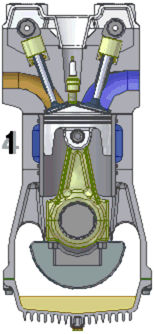AY Honors/Small Engines/Answer Key
Describe the design and operation of the two-cycle engine and the four-cycle engine.
The four-cycle engine is easier to understand, so it is presented here first. Once the four-cycle engine is understood, it is easier to understand the two-cycle engine.
Four-cycle Engine
A four-cycle engine is so named because it makes four strokes to generate power. These strokes are as follows:
- Intake Stroke: During this stroke, the piston draws a mixture of fuel and air into the cylinder. The fuel and air enters through an intake valve which opens during this stroke.
- Compression Stroke: Once the fuel and air have been drawn into the cylinder, the intake valve close and the piston returns towards the engine's head. This compresses the fuel.
- Power Stroke: When the piston reaches the top of the cylinder, the spark plug fires, igniting the compressed fuel and air mixture and causing an explosion. This explosion causes the gases to expand which powers the piston downwards again. This is where the engines power (and noise!) comes from.
- Exhaust Stroke: When the piston reaches the bottom of the cylinder, the exhaust valve opens, and as the piston returns to the top of the cylinder again, the exhaust gases are pushed out. When the clylinder reaches the top again, the four cycles are ready to repeat.
Two-cycle Engine
This link has an animation of a two-cycle engine in action. (We need to come up with our own animation here that can be freely distributed).
Power and Exhaust Stroke: In a two-cycle engine, the spark plug fires every time the piston reaches the top of the cylinder. This is the beginning of the power and exhaust cycle. As in the four cycle engine, the spark plug firing causes a compressed air/fuel mixture in the cylinder to explode, and the expanding gases drive the piston downward. As the cylinder goes down, it compresses another air/fuel mixture inside the crankcase - not inside the cylinder as in the four-stroke engine. The crankcase is the area beneath the piston, and the cylinder is the area above the piston. When the piston nears the bottom of this stroke, it uncovers an exhaust outlet and it also uncovers a passage between the crankcase and the cylinder. The compressed air-fuel mixture in the crankcase then rushes through this passage-way into the cylinder, forcing the exhaust gases out of the cylinder though the exhaust outlet. Some of the air/fuel mixture is also forced out the exhaust outlet, and this unfortunately decreases the engine's fuel efficiency and increases its pollution output. The piston's head is shaped in such a way as to minimize this waste, but it does not entirely eliminate it.
Intake and Compression Stroke: After the piston reaches the bottom of the stroke, it begins travelling upwards again, compressing the air/fuel mixture that rushed into the cylinder from the crankcase during the previous stroke, and simulataneously drawing more air and fuel into the crankcase. By the time the piston reaches the top of the cylinder, the air/fuel mixture is very highly compressed - much more compressed than it was in the crankcase. It is at this point in the cycle that the intake valve closes and the spark plug fires.
Because the crankcase is opened to the cylinder during its operation, oil in the crankcase makes its way into the cylinder where it is compressed and combusted along with the fuel. If this situation were ignored, the engine would soon burn up all its oil, leaving itself unlubricated. The engine would soon get so hot that its parts would fuse together and destroy itself. This is addressed by adding oil to the fuel (often one part oil to sixteen parts fuel). Thus the engine's oil supply is refreshed on every stroke of the piston. This unfortunately increases the pollution levels generated by two-stroke engines.
Name the parts of the two-cycle engine and tell what each part does.
- Spark Plug:
The spark plug generates an electrical spark igniting the air/fuel mixture when the piston reaches the top of the cylinder.
- Piston:
The piston travels up and down inside the cylinder. Its downward motion is propelled by an explosion of air and fuel ignited by the spark plug.
- Rod:
The rod connects the piston to the crankshaft, converting the psiton's up-and-down motion into rotary motion.
- Cranshaft:
The crankshaft transfers the engines power to the outside of the engine.
- Cylinder:
The cylinder is the space inside the engine block inwhich the piston moves. Combustion occurs at the top of the cylinder.
- Crankcase:
The crankcase is the cavity in the engine block beneath the cylinder. This is where fuel is drawn into the engine prior to being forced into the cylinder.
- Intake Port:
The intake port is the passage-way between the crankcase and the cylinder.
- Intake Valve:
The intake valve opens to allow the air/fuel/oil mixture to enter the crankcase during the piston's up-stroke stroke, and close to prevent its escape during the piston's downstroke.
- Exhaust Port:
The exhaust port is a hole in the cylinder wall through which the burnt fuel (exhaust) is expelled.
- Flywheel:
The flywheel is a mass attached to the crankshaft. It preserves the engines momentum, keeping the crankshaft turning between the explosions in the combustion chamber.
- Coil:
The coil is mounted near the flywheel which has a magnet embedded in it. As the flywheel swings the magnet past the coild, it generates a pulse of electricity. This electrical pulse is delivered to the spark plug.
- Fuel Filter:
The fuel filter captures dirt in the fuel, preventing it from entering the carburetor.
- Carburetor:
The carburetor is the device that mixes the fuel and air together prior to its being transferred into the engine.

